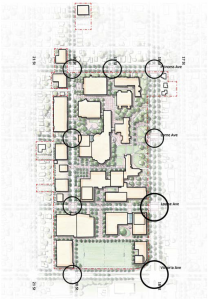Gateways & Wayfinding
Gateways are featured spaces that identify key points of entry and create a sense of welcome, arrival, and place. Beyond a welcome plaque, each gateway should be unique based on where it is situated, relative to the Campus and its surrounding environment. They should demarcate a transition between character areas within the Campus, and assist in wayfinding and orientation. Gateways can be created through the design of buildings, landscapes, art, signage or a combination of these elements.
As gateways are an essential part of a wayfinding strategy, they need to visibly stand out and be placed in strategic locations to draw visitors into the Campus. From there, other elements of the public realm and built environment should work together to contribute to wayfinding. Wayfinding tools include signage and mapping, streetscape elements, streetscape design, and building design such as gateway or landmark elements. As these elements are to provide easily understood and navigated routes for all users, accessibility must be of utmost priority when it comes to wayfinding.
The enhancement of 18th Avenue will be critical to the success of creating safe pedestrian crossings and connections to the Campus from the east neighbourhoods. It will also be important in providing a more welcoming interface. The pedestrian cross-walks and the signalization of the intersections need to be a coordinated part of the gateway design between the University and the City. The University should continue a conversation with the City and the Province to create a more pedestrian-friendly street condition for 18th Avenue where it engages the Campus.
One of the main issues the Campus has faced is the lack of a “front door” or arrival place. The Plan identifies nine gateway locations that would serve to mitigate this issue and create a better interface between BU and the surrounding community. The gateways reflect a hierarchy of entrances which include the main entrance into the Campus, intersections that represent the face and address of the University, and entrances that connect the University to the neighbourhood.
Primary Gateways
The Primary Campus Gateways are either the main entrances into the Campus or the major address and face to the community.
Secondary Gateways
The Secondary Campus Gateways are not as prominent as the Primary Gateways in terms of vehicular entry or volume of exposure but are significant because of their heritage representation and link to downtown Brandon.
Neighbourhood Gateways
The Neighbourhood Gateways are the main points of connection to the neighbourhoods and are intended to demarcate a transition between the Campus and surrounding community and provide clear wayfinding.
Pedestrian Gateways
The Pedestrian Gateways are pedestrian-only points of access.

